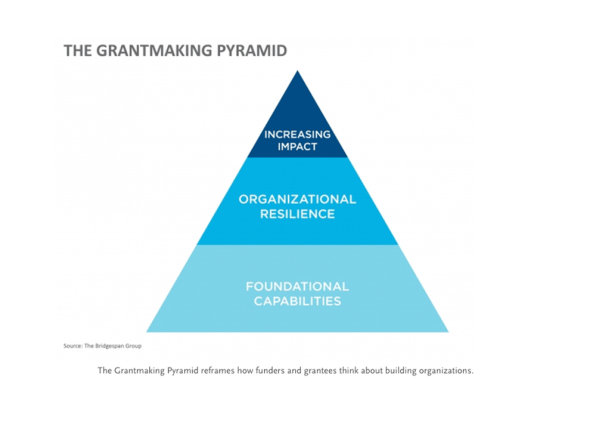This Grantmaking Pyramid Strategy Ensures That Nonprofits Won’t Topple
In 2005, one of the seemingly most successful nonprofits in the country requested the sector equivalent of a bailout. Communities in Schools, an organization that today serves 1.5 million disadvantaged kids, 91% of whom graduate high school or obtain a GED, approached a fleet of major foundations to show its books and ask for several million in emergency capacity building funds.
Turns out, the group had spent years accepting the most common kind of payment from foundations, supposedly results-driven grants, which poured money into expanding programs without covering basic institutional needs like staff training, facilities costs, tech upgrades, and the ability to create a cash reserve for unexpected costs. Eventually, operating costs were stretched so thin that the organization was struggling to keep up its standards and measure success. It was operating in the red, borrowing from accounts that should have gone to one function to cover another.

A few major funders including the Gates Foundation stepped in to assist, offering several million so that CIS could shore up its financials and shift toward only accepting more logically structured grants. But as Michael Etzel, a partner at Bridgespan, a nonprofit consultancy, and Hilary Pennington, a vice president at the Ford Foundation, have discovered, that’s far from a one-off tale of woe. It’s often the norm.
The research duo, who highlight CIS’s struggles in a recent Stanford Social Innovation Review report, have found that poorly structured grants are forcing many groups to funnel the majority of their cash into programming and expansion. At the same time, the only way to thrive in the long run seems to be the opposite: Much like companies offering standard services or products, nonprofits need to build stability, investing in talent, training, R&D, and non-dilapidated offices, while putting aside some cash so they don’t live and die by the next grant cycle.
After surveying more than 300 groups that received grants from 15 major U.S. foundations, Bridgespan has found that over half of those grantees have “frequent of chronic deficits,” meaning they’ve overspent in some areas and may have used money budgeted elsewhere make up the difference for at least two years within a five-year period. Also, 40% have less than three months worth of cash reserves on hand as an emergency fund, and 10% have no parachute at all.
At the same time, most foundations only allocate about 15% of their grants toward indirect costs like overhead. Roughly 75% of all foundation grants are also restricted, meaning they can’t be banked to create a surplus—everything must be spent not saved.
Many grant makers and recipients may recognize these problems but have trouble starting and structuring conversations about solutions. So Etzel and Pennington have drawn a picture.

The image above is called the Grantmaking Pyramid. “From the perspective of a nonprofit leader, the pyramid offers a guide to articulating an organization’s needs,” says Etzel in an email. What it doesn’t do is represent relative amounts of funding. The goal, Etzel says, is to take a step back from the sector’s “relentless pursuit of increasing impact” to ensure investments help a group smartly evolve.
So the pyramid is a shorthand for priorities. “The original inspiration was a sort of “Maslow’s hierarchy”–organizing and making sense of the multiple layers of funding an organization needs to be strong,” adds Etzel.
As a visual aid, Etzel and Pennington hopes this can be exhibit A in any conversation among givers and recipients about true donation needs. The bottom or “foundational capabilities” level represents increasing discussion and emphasis around classic overhead needs, with the next important layer being “organizational resilience”–a euphemism for “unspent cash.”

If donors can satisfy both, then the idea of “increasing impact” becomes more realistic because the group won’t go bankrupt while trying to do so. Per the SSIR report: “It’s time to end Potemkin philanthropy that builds the façade of successful organizations that, in fact, teeter on the brink of collapse.”
To that end, Ford Foundation is now applying thinking to its own portfolio. In 2016, the group launched the BUILD program, which will invest a total of $1 billion in back-end support for a few hundred grantees.
As part of that initiative, Ford is aiming to make more general support grants, too, and regardless will allocate at least 20% of any investment toward overhead. Together, that may tackle another issue: In general, the group found, it was making short-term grants of often a year or two, which–especially for organizations without money in the bank–didn’t provide the security to take risks or grow.
So far, Ford has issued 86 of these grants. To really complete its social justice mission, the organization is looking beyond just shoring up the financials of each recipient’s pyramid stack; the money will be spent in ways that encourage core values of diversity, equity, inclusion, and more learning and evaluation.
Too many philanthropic grants focus on expanding new programs at the expense of nonprofits’ internal structure and stability, but a new initiative is looking put the focus on building organizational strength from the ground up.
In 2005, one of the seemingly most successful nonprofits in the country requested the sector equivalent of a bailout. Communities in Schools, an organization that today serves 1.5 million disadvantaged kids, 91% of whom graduate high school or obtain a GED, approached a fleet of major foundations to show its books and ask for several million in emergency capacity building funds.
Fast Company , Read Full Story
(56)













